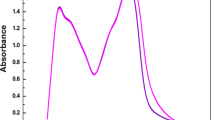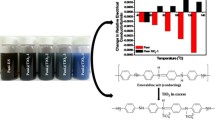Abstract
This paper involves the synthesis of polyaniline composite with photoadduct of potassium hexacyanoferrate and imidazole via photochemical route by oxidative polymerization technique by ammonium persulphate. The photoadduct has been synthesized by photoirradiation followed by substitution with imidazole ligand. The photoaquation, substitution and successful synthesis has been proved by recording pH, UV visible spectra before and after irradiation and XRD of photoadduct. The as synthesized composite has been subjected to various characterizations like elemental analysis, UV–Visible spectra, FTIR, XRD, SEM, and TG/DTG. XRD of photoadduct shows crystalline structure which has been retained in the composite, changing the amorphous structure of polyaniline into the crystalline one, hence proving the insertion of photoadduct in the polymer chain. Various parameters like crystallite size (L), interplanar distance (d), micro strain (ε), dislocation density (δ) and distortion parameters (g) were calculated from XRD data. Thermal analysis shows the high thermal stability of composite which can be due to strong interaction between polymer chain and the photoadduct which restricts the thermal motion of polyaniline and thus enhances the thermal stability of composite.











Similar content being viewed by others

References
Lange U, Roznyatovskaya NV, Mirsky VM. Conducting polymers in chemical sensors and arrays. Anal Chim Acta. 2008;614:1–26.
Arun N, Narayan KS. Conducting polymers as antennas for probing biophysical activities. J Phys Chem B. 2008;112:1564–9.
Chiou NR, Lee LJ, Epstaein AJ. Self assembled polyaniline nanofibers/nanotubes. Chem Mater. 2007;19:3589–91.
Rather MS, Majid K, Wanchoo RK, Singla ML. Synthesis, characterization, and thermal study of polyaniline composite with the photoadduct of potassium hexacyanoferrate(II) involving hexamine ligand. J Therm Anal Calorim. 2013;112:893–900.
Wang S, Huang Z, Wang J. Thermal stability of several polyaniline/rare earth oxide composites (I): polyaniline/CeO2 composites. J Therm Anal Cal. 2012;107:1199–12036.
Gao Y, Shan DC, Cao F, Gong J, Li X, Ma HY. Silver polyaniline composite nanotubes: one step synthesis and electrocataytic activity for neurotransmitter dopamine. J Phys Chem C. 2009;113:15175–85.
Ameer Q, Adeloju SB. Polypyrrole based electronic noses for environmental and industrial analysis. Sensor Actuat B. 2005;106:541–52.
Hua B, Gaoquan S. Gas sensors based on conducting polymers. Sensors. 2007;7:267–307.
Kulkaini MV, Viswanath AK, Khanna PK. Synthesis, characterization and morphology of p –Toluene sulphonic acid-doped Polyaniline: a material for humidity sensing application. J Polym Sci B Polym Phys. 2005;43:2161–9.
Trojanowicz M. Application of conducting polymers in chemical analysis. Microchima Acta. 2003;143:75–91.
Chen GZ, Shaffer MSP, Coleby D, Dixon G, Zhou W, Fray DJ, Windle AH. Carbon nanotube and polypyrrole composites: coating and doping. Adv Mater. 2000;12:522–6.
An KH, Jeong SH, Hwang HR, Lee YH. Enhanced sensitivity of a gas sensor incorporating single walled carbon nanotube- polypyrrole nanocomposites. Adv Mater. 2004;16:1005–9.
Rafiqi FA, Rather MS, Majid K. Doping polyaniline with copper bisglycinate[Cu(gly)2]—Synthesis, characterization and thermal study. Synthetic Met. 2013;171:32–8.
Mosner P, Vosejpkova K, Koudelka L, Benes L. Thermal studies of ZnO–B2O3–P2O5–TeO2 glasses. J Therm Anal Calorim. 2012;107:1129–35.
Kutnyanszky E, Vancso GJ. Nanomechanical properties of polymer brushes by colloidal AFM probes. Eoropean. Polym J. 2012;48:8–15.
Hongyao X, Shiao WK, Juh SL, Feng CC. Thermal Properties, and T g increase mechanism of poly(acetoxystyrene-co-octavinyl-polyhedral oligomeric silsesquioxane) hybrid nanocomposites. Macromolecules. 2002;35:8788–93.
Elisabeth HB, Langveld MW, Ulrich S. New trends in the use of transition metal-ligand complexes for applications in electroluminescent devices. Adv Mater. 2005;17:1109–21.
Zhang ZM, Wei ZX, Wan MX. Nanostructures of Polyaniline doped with inorganic acids. Macromolecules. 2002;35:5937–42.
Yuan S, Jaramillo R, Rosenbaum TF, Yu L. Synthesis and characterization of conjugated polymers containing first row transition metal complexes. Macromolecules. 2006;39:8652–8.
Phang SW, Tadokoro M, Watanabe J, Kuramoto N. Microwave absorption behaviors of polyaniline nanocomposites containing TiO2 nanoparticles. Curr Appl Phy. 2008;8:391–4.
Vogler A, Kunkely H. Electronic spectra and photoreactivity of cyclopentadienyl complexes. Coord Chem Rev. 2001;211:223–33.
Singh A, Narendra PS, Preeti S, Ram AS. Synthesis and characterization of conducting polymer composites based on polyaniline–polyethylene glycol–zinc sulfide system. J Polym Res. 2011;18:67–77.
Szlarzewicz J, Samotus A. Photochemical reactions of molybdenum and tungsten octacyanometallates(IV) in acidic aqueous media containing 2,2′-bipyridyl or 1,10-phenanthroline. Transit Met Chem. 1995;20:174–8.
Majid K, Rafiqi FA, Rather MS. Photo substituted synthesis, characterization and thermal kinetics of potassium hexacyanoferrate with monoethanolamine. Elixir Chem Phys. 2011;36:3245–7.
Majid K, Awasthi S, Singla ML. Low temperature sensing capability of polyaniline and Mn3O4 composite as NTC material. Sensor Actuat A. 2007;135:113–8.
Acknowledgements
The authors are grateful to Department of Science and Technology, Government of India for financial assistance to carry out this research work under research project No: (SR/NM/NS-97/2008). One of the authors Mr. Mohammad Sideeq Rather is highly thankful to University Grants Commission for the award of fellowship. The authors are also grateful to Prof Rajat Gupta, Director, NIT Srinagar and Dr S A Shah, Head, Department of Chemistry for their help and support.
Author information
Authors and Affiliations
Corresponding author
Rights and permissions
About this article
Cite this article
Rather, M.S., Majid, K., Wanchoo, R.K. et al. Role of photoadduct of K4Fe(CN)6 and C3H4N2 in improving thermal stability of polyaniline composite. J Therm Anal Calorim 117, 611–619 (2014). https://doi.org/10.1007/s10973-014-3834-z
Received:
Accepted:
Published:
Issue Date:
DOI: https://doi.org/10.1007/s10973-014-3834-z



